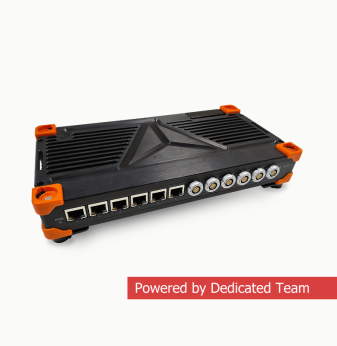Developing Embedded Software for Wearable Baby Health Trackers: Key Challenges and Solutions
The demand for wearable baby health trackers is rising as parents seek reliable ways to monitor their infants' vital signs in real-time. These smart baby monitoring devices track temperature, heart rate, oxygen levels, and sleep patterns, offering peace of mind and medical-grade insights.
At the core of these devices lies embedded software, ensuring accuracy, low power consumption, and secure data transmission. However, developing software for baby health monitoring wearables presents unique challenges. In this article, we explore the key aspects of embedded software development for baby trackers, the technologies involved, and solutions to common challenges.
Why Embedded Systems Are Essential for Baby Health Trackers
Unlike general-purpose computing devices, embedded systems in baby health wearables are optimized for efficiency, reliability, and safety. Here’s why they play a critical role:
Real-Time Health Monitoring
Wearable baby health devices continuously track vital signs such as heart rate, skin temperature, and oxygen levels. Embedded software processes sensor data instantly, providing real-time alerts if abnormalities are detected.
Low-Power Consumption for Longer Battery Life
Baby trackers need to operate for days or even weeks on a single charge. Low-power microcontrollers (MCUs) and efficient firmware design ensure minimal energy consumption without sacrificing performance.
Wireless Connectivity & Secure Data Transmission
Smart baby monitors transmit health data via Bluetooth Low Energy (BLE), Wi-Fi, or NB-IoT, allowing parents to monitor their baby remotely. Data encryption and secure cloud storage protect sensitive infant health information.
Medical-Grade Accuracy & Compliance
Baby monitoring devices must comply with strict medical regulations (such as FDA, CE, and ISO 13485) to ensure accurate and safe operation. Embedded software must filter sensor noise, minimize false alarms, and deliver precise health insights.

Key Technologies in Embedded Software for Baby Wearables
Developing smart baby monitoring devices involves integrating advanced embedded technologies for accurate and reliable tracking. Here’s an overview of the essential components:
1. IoT Sensors for Infant Health Tracking
Baby wearables use biosensors to collect health data, including:
- Optical Sensors – Measure heart rate and oxygen levels (SpO2).
- Thermal Sensors – Monitor skin and ambient temperature.
- Accelerometers & Gyroscopes – Detect movement, sleep patterns, and potential distress signals (e.g., no movement for extended periods).
2. Low-Power Microcontrollers (MCUs) for Energy Efficiency
To extend battery life, embedded software must optimize:
- Sleep modes & duty cycling (turning sensors on/off based on necessity).
- Ultra-low power MCUs (such as ARM Cortex-M or RISC-V) for energy-efficient processing.
- Wireless data transmission frequency to reduce power consumption.
3. Wireless Connectivity for Remote Monitoring
Baby trackers use different connectivity options depending on their function:
| Technology | Range | Power Consumption | Ideal Use Case | Key Benefit |
| Bluetooth Low Energy (BLE) | Up to 100m | Very Low | Wearable baby monitors | Long battery life, fast data sync |
| Wi-Fi | Up to 100m | Medium | Remote monitoring with cameras | High bandwidth for real-time video |
| NB-IoT | City-wide | Low | Hospital-grade baby health monitors | Reliable connection in medical settings |
| LoRaWAN | Up to 15km | Very Low | Long-range infant tracking | Extended range with minimal power use |
4. AI & Machine Learning for Health Insights
Artificial intelligence enhances baby health monitoring devices by:
- Predicting potential health risks (e.g., sudden drops in oxygen levels).
- Detecting sleep apnea or irregular breathing patterns.
- Personalizing alerts based on the baby’s normal behavior trends.
5. Secure Cloud Integration & Data Privacy
Baby health trackers store and process sensitive data. Secure embedded software development ensures:
- End-to-end encryption (AES-256, TLS 1.2/1.3) to protect transmitted data.
- HIPAA & GDPR compliance for handling medical-grade health data.
- Secure OTA (Over-the-Air) firmware updates to patch vulnerabilities.
Challenges in Developing Embedded Software for Baby Wearables
Creating wearable baby health devices comes with significant technical and regulatory challenges. Here are the top challenges and how to overcome them:
1. Ensuring High Accuracy & Reducing False Alarms
Baby monitors must distinguish between normal variations and actual health concerns. Solution:
- Use adaptive algorithms to filter out motion artifacts and noise.
- Implement multi-sensor data fusion for greater reliability.
2. Optimizing Power Efficiency for Continuous Tracking
Parents expect long battery life without frequent charging. Solution:
- Implement event-driven sensor activation instead of continuous monitoring.
- Utilize low-power modes and efficient scheduling in firmware.
3. Securing Wireless Data Transmission
Baby health data must be protected from cyber threats. Solution:
- Use strong encryption protocols (AES-256, WPA3).
- Enable device authentication to prevent unauthorized access.
4. Regulatory Compliance & Certifications
Medical-grade wearables must meet FDA, CE, and ISO 13485 standards. Solution:
- Ensure sensor calibration & clinical validation before market launch.
- Maintain compliance documentation for certification processes.
Case Study: AI-Powered Baby Monitoring System
At Promwad, we helped develop an AI-powered baby health tracker with:
- BLE connectivity for real-time data transmission.
- AI-based sleep monitoring to detect irregular breathing patterns.
- Low-power firmware optimization, extending battery life to two weeks.
For more details, explore our embedded system development for healthcare devices.
Future Trends in Smart Baby Health Trackers
The baby health wearables market is evolving with exciting innovations:
1. Predictive AI for Infant Health Monitoring
AI will detect early signs of illness by analyzing long-term data trends.
2. Wireless Charging for 24/7 Wearables
Future wearables will feature wireless charging docks, ensuring continuous operation.
3. Integration with Pediatric Telemedicine
Smart baby monitors will sync with telemedicine platforms, allowing doctors to remotely assess infant health.
4. Smart Clothing with Embedded Sensors
Innovative fabrics with woven biosensors will enable non-intrusive baby health monitoring.
Conclusion: The Future of Embedded Baby Health Tech
Developing embedded software for wearable baby health trackers is both challenging and rewarding. With the right low-power design, AI integration, and secure data transmission, smart baby monitors can enhance infant care and safety.
At Promwad, we specialize in custom embedded development for baby monitoring devices. If you're looking to develop a new baby health wearable, contact us to explore cutting-edge solutions.
Our Case Studies in Industrial Design





